Why Cant Your Parents Produce You Again What Is the Science of Everbody Is Different
1 APPENDIX TO LIFE
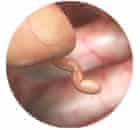
The appendix gets a bad press. It is ordinarily treated every bit a body role that lost its part millions of years ago. All it seems to do is occasionally get infected and cause appendicitis. Yet recently information technology has been discovered that the appendix is very useful to the bacteria that help your digestive organization part. They use it to go respite from the strain of the frenzied activity of the gut, somewhere to breed and aid keep the gut's bacterial inhabitants topped up. And then treat your appendix with respect.
2 SUPERSIZED MOLECULES
Practically everything we experience is made up of molecules. These vary in size from simple pairs of atoms, like an oxygen molecule, to complex organic structures. Simply the biggest molecule in nature resides in your body. Information technology is chromosome 1. A normal human cell has 23 pairs of chromosomes in its nucleus, each a unmarried, very long, molecule of Deoxyribonucleic acid. Chromosome 1 is the biggest, containing around 10bn atoms, to pack in the corporeality of information that is encoded in the molecule.
3 Cantlet COUNT
It is hard to grasp just how small the atoms that make up your trunk are until yous have a look at the sheer number of them. An developed is made upwards of around 7,000,000,000,000,000,000,000,000,000 (7 octillion) atoms.
4 FUR LOSS

It might seem hard to believe, just we accept about the same number of hairs on our bodies as a chimpanzee, information technology's just that our hairs are useless, so fine they are most invisible. We aren't sure quite why we lost our protective fur. Information technology has been suggested that it may have been to aid early on humans sweat more than easily, or to make life harder for parasites such as lice and ticks, or even considering our ancestors were partly aquatic.
Simply perchance the most attractive idea is that early on humans needed to co-operate more when they moved out of the trees into the savanna. When animals are bred for co-operation, every bit nosotros once did with wolves to produce dogs, they become more than like their infants. In a fascinating 40-yr experiment starting in the 1950s, Russian foxes were bred for docility. Over the menses, adult foxes become more and more like large cubs, spending more than fourth dimension playing, and developing drooping ears, floppy tails and patterned coats. Humans similarly have some characteristics of infantile apes – large heads, small mouths and, significantly hither, finer torso hair.
5 GOOSEBUMP EVOLUTION
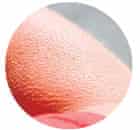
Goosepimples are a remnant of our evolutionary predecessors. They occur when tiny muscles around the base of each hair tense, pulling the hair more erect. With a decent covering of fur, this would fluff upward the glaze, getting more air into information technology, making it a better insulator. Simply with a human'southward thin torso hair, it just makes our skin look strange.
Similarly nosotros go the bristling feeling of our hair standing on end when nosotros are scared or experience an emotive retention. Many mammals fluff upward their fur when threatened, to look bigger and and so more dangerous. Humans used to have a similar defensive fluffing up of their body hairs, but in one case once again, the effect is now ruined. Nosotros notwithstanding feel the sensation of hairs standing on terminate, but proceeds no visual bulk.
6 Infinite TRAUMA
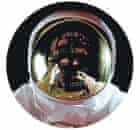
If sci-fi movies were to be believed, terrible things would happen if your body were pushed from a spaceship without a suit. Only it'south generally fiction. At that place would exist some discomfort as the air inside the trunk expanded, but nothing like the exploding trunk parts Hollywood loves. Although liquids do boil in a vacuum, your blood is kept under pressure by your circulatory organization and would be just fine. And although infinite is very cold, you would not lose rut specially speedily. Every bit Thermos flasks demonstrate, a vacuum is a cracking insulator.
In practice, the thing that will impale you in space is simply the lack of air. In 1965 a test field of study's adapt sprang a leak in a Nasa vacuum bedchamber. The victim, who survived, remained conscious for around fourteen seconds. The exact survival limit isn't known, only would probably exist one to two minutes.
7 ATOMIC Collapse
The atoms that make up your body are by and large empty space, so despite in that location existence so many of them, without that infinite y'all would shrink into a tiny volume. The nucleus that makes up the vast bulk of the matter in an atom is then much smaller than the whole structure that it is comparable to the size of a fly in a cathedral. If you lost all your empty atomic space, your body would fit into a cube less than 1/500th of a centimetre on each side. Neutron stars are made up of thing that has undergone exactly this kind of compression. In a single cubic centimetre of neutron star material there are around 100m tons of matter. An entire neutron star, heavier than our sunday, occupies a sphere that is roughly the size across of the Island of Wight.
viii ELECTROMAGNETIC REPULSION
The atoms that brand up matter never bear on each other. The closer they become, the more than repulsion there is betwixt the electrical charges on their component parts. It's like trying to bring 2 intensely powerful magnets together, northward pole to north pole. This even applies when objects appear to be in contact. When you lot sit on a chair, yous don't touch it. Y'all float a tiny altitude above, suspended by the repulsion between atoms. This electromagnetic force is vastly stronger than the forcefulness of gravity – around a billion billion billion billion times stronger. You can demonstrate the relative strength by property a fridge magnet nigh a fridge and letting go. The electromagnetic forcefulness from the tiny magnet overwhelms the gravitational attraction of the whole Earth.
9 STARDUST TO STARDUST

Every cantlet in your body is billions of years erstwhile. Hydrogen, the most common element in the universe and a major feature of your body, was produced in the big bang 13.7bn years ago. Heavier atoms such as carbon and oxygen were forged in stars between 7bn and 12bn years ago, and blasted across space when the stars exploded. Some of these explosions were so powerful that they also produced the elements heavier than iron, which stars can't construct. This ways that the components of your trunk are truly aboriginal: you are stardust.
x THE Quantum Body
One of the mysteries of science is how something every bit apparently solid and straightforward every bit your body tin be made of strangely behaving quantum particles such as atoms and their constituents. If you ask most people to describe a film of one of the atoms in their bodies, they will produce something like a miniature solar organisation, with a nucleus as the sun and electrons whizzing round like planets. This was, indeed, an early model of the atom, but it was realised that such atoms would collapse in an instant. This is because electrons have an electrical charge and accelerating a charged particle, which is necessary to keep it in orbit, would go far requite off energy in the form of light, leaving the electron spiralling into the nucleus.
In reality, electrons are bars to specific orbits, as if they ran on rails. They can't be anywhere between these orbits but have to make a "breakthrough jump" from one to another. What's more, as breakthrough particles, electrons exist as a collection of probabilities rather than at specific locations, and then a better motion picture is to evidence the electrons as a set of fuzzy shells around the nucleus.
eleven RED BLOODED
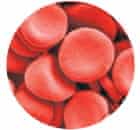
When you see blood oozing from a cut in your finger, y'all might assume that it is cherry-red because of the fe in information technology, rather every bit rust has a reddish hue. Just the presence of the iron is a coincidence. The red colour arises considering the iron is jump in a ring of atoms in haemoglobin chosen porphyrin and information technology'southward the shape of this structure that produces the colour. Just how red your haemoglobin is depends on whether there is oxygen bound to it. When there is oxygen nowadays, it changes the shape of the porphyrin, giving the cherry-red blood cells a more vivid shade.
12 GOING VIRAL

Surprisingly, non all the useful DNA in your chromosomes comes from your evolutionary ancestors – some of it was borrowed from elsewhere. Your Deoxyribonucleic acid includes the genes from at to the lowest degree 8 retroviruses. These are a kind of virus that makes use of the prison cell'south mechanisms for coding Dna to have over a cell. At some point in human history, these genes became incorporated into homo Deoxyribonucleic acid. These viral genes in DNA now perform of import functions in human reproduction, yet they are entirely alien to our genetic ancestry.
xiii OTHER LIFE
On sheer count of cells, there is more bacterial life inside you than homo. At that place are around 10tn of your own cells, but 10 times more bacteria. Many of the bacteria that call you habitation are friendly in the sense that they don't do whatsoever damage. Some are beneficial.
In the 1920s, an American engineer investigated whether animals could alive without leaner, hoping that a leaner-free world would exist a healthier 1. James "Art" Reyniers made information technology his life'south piece of work to produce environments where animals could be raised bacteria-costless. The result was articulate. It was possible. Only many of Reyniers'due south animals died and those that survived had to be fed on special nutrient. This is because bacteria in the gut help with digestion. You lot could exist with no bacteria, simply without the help of the enzymes in your gut that leaner produce, yous would need to eat food that is more loaded with nutrients than a typical diet.
14 EYELASH INVADERS
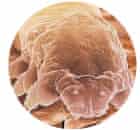
Depending on how old you are, information technology'due south pretty probable that you have eyelash mites. These tiny creatures alive on sometime pare cells and the natural oil (sebum) produced past human hair follicles. They are ordinarily harmless, though they tin crusade an allergic reaction in a minority of people. Eyelash mites typically grow to a third of a millimetre and are near-transparent, so you are unlikely to see them with the naked center. Put an eyelash hair or eyebrow hair nether the microscope, though, and you may notice them, as they spend most of their time right at the base of the pilus where it meets the skin. Around half the population have them, a proportion that rises as we go older.
15 PHOTON DETECTORS
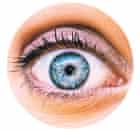
Your optics are very sensitive, able to detect but a few photons of light. If y'all have a look on a very clear night at the constellation of Andromeda, a little fuzzy patch of light is simply visible with the naked center. If you can brand out that tiny hulk, you are seeing as far as is humanly possible without technology. Andromeda is the nearest large milky way to our own Galaxy. But "near" is a relative term in intergalactic infinite – the Andromeda galaxy is 2.5m low-cal years abroad. When the photons of light that hit your centre began their journey, in that location were no homo beings. We were yet to evolve. Yous are seeing an almost inconceivable distance and looking back in time through 2.5m years.
16 SENSORY TALLY
Despite what you've probably been told, you have more than v senses. Here'south a simple example. Put your hand a few centimetres abroad from a hot fe. None of your 5 senses can tell you the atomic number 26 volition burn you. Nevertheless you lot can feel that the iron is hot from a distance and won't affect information technology. This is cheers to an extra sense – the oestrus sensors in your pare. Similarly we can detect pain or tell if nosotros are upside downward.
Some other quick examination. Shut your eyes and touch your nose. You aren't using the large five to observe it, but instead proprioception. This is the sense that detects where the parts of your trunk are with respect to each other. It'south a meta-sense, combining your brain's noesis of what your muscles are doing with a feel for the size and shape of your trunk. Without using your basic five senses, you tin can all the same guide a paw unerringly to impact your nose.
17 Existent Historic period

Just similar a chicken, your life started off with an egg. Not a chunky thing in a vanquish, merely an egg nonetheless. Nevertheless, there is a significant difference between a man egg and a craven egg that has a surprising result on your age. Human eggs are tiny. They are, after all, just a single prison cell and are typically effectually 0.2mm across – near the size of a printed total finish. Your egg was formed in your mother – but the surprising thing is that it was formed when she was an embryo. The formation of your egg, and the half of your DNA that came from your female parent, could be considered as the very first moment of your existence. And information technology happened before your mother was born. Say your mother was xxx when she had you, and so on your 18th birthday you were arguably over 48 years one-time.
xviii EPIGENETIC INFLUENCE
Nosotros are used to thinking of genes as being the controlling factor that determines what each of us is like physically, only genes are just a tiny office of our DNA. The other 97% was thought to exist junk until recently, simply we now realise that epigenetics – the processes that get on exterior the genes – as well have a major influence on our development. Some parts deed to control "switches" that turn genes on and off, or programme the production of other key compounds. For a long time it was a puzzle how around twenty,000 genes (far fewer than some breeds of rice) were plenty to specify exactly what we were similar. The realisation at present is that the other 97% of our Deoxyribonucleic acid is equally important.
xix CONSCIOUS ACTION
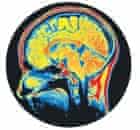
If you are like most people, you will locate your conscious mind roughly behind your eyes, as if there were a little person sitting at that place, steering the much larger automaton that is your body. You know there isn't actually a tiny effigy in there, pulling the levers, only your consciousness seems to have an independent existence, telling the residue of your body what to do.
In reality, much of the command comes from your unconscious. Some tasks become automatic with practice, so that we no longer need to think most the basic actions. When this happens the procedure is handled by one of the most primitive parts of the brain, close to the encephalon stem. However even a clearly conscious action such as picking upwards an object seems to take some unconscious precursors, with the brain firing up before you brand the decision to act. At that place is considerable argument over when the conscious heed plays its office, but in that location is no doubt that we owe a lot more to our unconscious than we oftentimes let.
20 OPTICAL DELUSION
The picture of the earth we "see" is artificial. Our brains don't produce an image the style a video camera works. Instead, the brain constructs a model of the world from the information provided by modules that measure out lite and shade, edges, curvature and and so on. This makes it uncomplicated for the brain to paint out the blind spot, the area of your retina where the optic nervus joins, which has no sensors. It besides compensates for the rapid jerky movements of our eyes called saccades, giving a false picture of steady vision.
But the downside of this procedure is that it makes our eyes easy to fool. Telly, films and optical illusions work past misleading the brain about what the eye is seeing. This is likewise why the moon appears much larger than it is and seems to vary in size: the true optical size of the moon is similar to a hole created by a hole punch held at arm's length.
Source: https://www.theguardian.com/science/2013/jan/27/20-human-body-facts-science
0 Response to "Why Cant Your Parents Produce You Again What Is the Science of Everbody Is Different"
Post a Comment